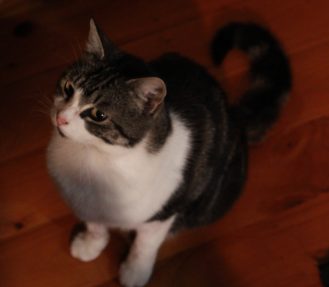Titre tests and vaccinations in cats
As more people are becoming aware of the options available to maximize cat health I am getting more enquiries about vaccinations and titre testing for cats.
Cats are not small dogs but the principles of managing their health are very similar. Feed them species appropriate diets, minimize chemical burdens and vaccinate minimally.
The most important cat disease in Australia for which we vaccinate is Feline Panleucopaenia (Feline Enteritis, FE) and is most similar to Parvovirus in dogs.
This is the disease that you hear about most often in the media with the traditional alarm.
It is a serious disease and all cats should be vaccinated against it at the right age as it usually affects young or stray cats.
Kittens that have come from good homes will have maternally derived antibodies that last up to about 10- 12 weeks of age and should then have a vaccination for FE which has been shown to confer a long duration of protection (3 years to lifelong).
The minimum frequency to vaccinate for this disease is 3 years according to the most recent World Small Animal Veterinary Association (WSAVA) guidelines and since it is a disease that mostly, if not exclusively, attacks cats under 12 months of age the need to revaccinate at all is arguable. It would be advisable to vaccinate breeding queens prior to mating to confer protection to the kittens.
The most common cat disease however is what is termed ‘cat flu’ but is not influenza at all. Like influenza however, the respiratory diseases that are linked to this syndrome are known to be changeable and unpredictable both in the manifestation of symptoms and the protection that infection or vaccination confers. Cat flu is actually two viruses against which we vaccinate. (Feline Herpes virus 1 known as Rhinotracheitis and Feline Calicivirus FRFC). As a modified live vaccine it gives the best protection but also runs the risk of producing the disease.
It is generally recognised that immunity to the feline respiratory disease syndrome (cat flu) is not necessarily protective and may do nothing more than alleviate the severity of symptoms.
Cats that have been infected with these viruses can become chronic carriers and can exhibit permanent symptoms of watery eyes or recurrent symptoms when stressed. These cats will not be protected by vaccination and will be infective to other cats that are susceptible so there are many frustrations in managing viral respiratory diseases in cats. Mostly for this reason alone I choose to treat these cats with homeopathy combined with raw diets as it alleviates the symptoms of disease and keeps cats resilient to infection.
Recommendations for the frequency of vaccination for this syndrome which is contained in F3 or F4 vaccines is very variable from 6 to 12 to 36 months.
WSAVA guidelines recommend F3 as a core vaccination of minimum duration 3 years. Cats can also become chronic carriers of these viruses and the disease will emerge at times of stress irrespective of vaccination status.
I won’t discuss vaccinating for Feline Leukaemia and Feline Aids viruses here as it is a whole different subject except to say that I usually do not recommend giving these vaccines (F4 or F5).
Antibody titre testing is a blood test that is used to determine the presence of antibody to disease. Whilst this a simple test to perform it is less simple to interpret the results in terms of protection status. For example, in dog diseases (Distemper, Hepatits and Parvovirus, DHP, C3) the levels of antibody correlate well with levels of protection whereas in cats the levels of antibody do not necessarily indicate protection to the respiratory diseases. Feline enteritis antibody (the most important disease) does correlate to protection.
Fortunately there is a good alternative to repeated vaccination for cat flu in the form of homeopathic nosode that will protect in the face of challenge. Unlike vaccination, the nosode does not produce antibody to disease but can be used safely and effectively both for cats that are exhibiting symptoms of cat flu and for those in the face of challenge as protection from full blown disease.
This is my preferred treatment method and needs to be recognised as a safe alternative to repeated vaccination for cats at risk.
Given that WSAVA guidelines recommend 3 yearly vaccinations for cats the requirement to vaccinate every year should be changed in Australian boarding cattery guidelines to bring them into accord with current evidence base.
Given also that Feline Enteritis (parvo) is a disease for which vaccination probably confers lifelong protection it is most likely not necessary to repeatedly vaccinate for this in cats older than a year of age.
Paws to Heal will use Cat Flu Nosode for cats at risk (boarding or stress) and also as a treatment for cats with respiratory disease. In the rare cases of Feline Enteritis that can occur in young cats the Feline Enteritis nosode has also been used to successfully treat the disease in strong kittens that were vaccinated too early to obtain acquired immunity.
Under WSAVA guidelines, three yearly titre testing and certificates should also be sufficient alternatives to yearly vaccinations combined with the added assurance that nosodes provide when required. Most veterinarians will be unable to supply nosodes and will recommend vaccination and each case must then be assessed on a risk/benefit basis.
Individualised vaccination programs are becoming more recognised, so if you do not have access to a homeopathic or integrative practitioner then please ask your vet for an individual assessment of your cat’s requirements.
